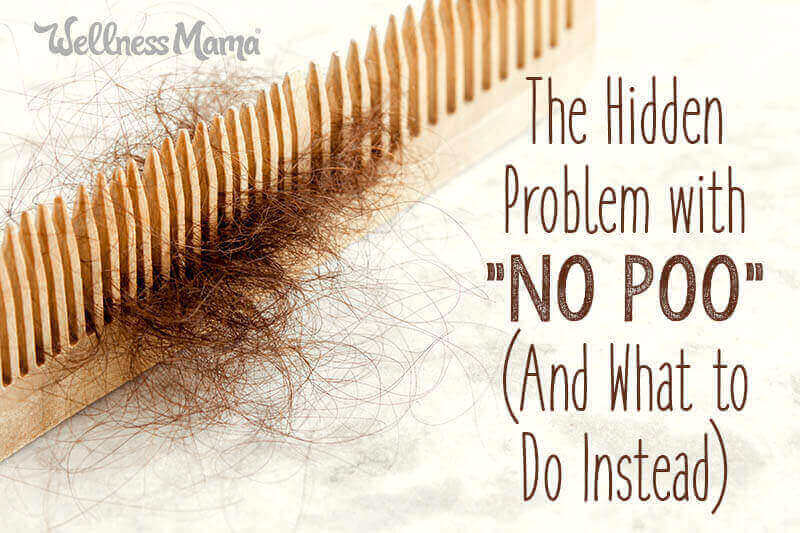As women, we tend to be finicky about our hair: all the curly-haired girls want straight hair and all the straight-haired girls want curls. But we all have one thing in common: the desire to have beautiful, healthy hair, preferably in a natural way.
Lots of naturally-minded folks recommend no poo, but is it really best for your hair?
What Is No Poo?
In case you’ve been living under a rock or you’re new to the crunchy mama crowd, “no poo” refers to your hair, not the other thing it sounds like.
Those who practice “no poo” are simply forgoing shampoo in favor of using baking soda to wash their hair. Typically, proponents of the no poo method suggest using diluted baking soda to give your hair a scrub, followed by a rinse of diluted apple cider vinegar.
It sounds like the perfect solution: natural and cheap. However, if you’ve gone that route, odds are, you’ll come to some bumps in the road sooner or later.
The Problem with No Poo
Baking soda sounds like a perfect choice for keeping your coif clean because it’s such a great cleanser. After all, I use it in my homemade cleaning supplies all the time. Try to use it for long though, and you’ll see why it isn’t right for hair maintenance.
Lots of us start out loving the no poo method: it seems to create manageable, clean, even bouncy, voluminous hair. But before long, many will start to notice something: dry, unmanageable hair. Breakage. Buildup. You might even be tempted to go back to conventional hair care products just to restore our locks to health.
There are a few reasons for things going south:
Baking Soda= Wrong pH for Hair
Because the natural pH of hair and skin is between 4.5-5.5, it is slightly acidic. With a pH of 9, baking soda differs vastly on the pH scale from hair. It is much more alkaline.
When you repeatedly wash your slightly acidic hair with a highly alkalized solution, you force your hair to drastically change its natural makeup. Eventually, your hair will become dry, frizzy, and begin to suffer from breakage.
The purpose for the apple cider vinegar rinse following a baking soda wash is to restore acidity to your hair. However, most people are unable to perfectly dilute and balance each step in order to restore proper pH. Not to mention, it’s difficult to evenly wash every strand of hair with each solution, making sure none are missed.
Baking Soda is Abrasive
Baking soda is one of the best natural solutions for scrubbing everything from tile grout to bathtubs. It is not great, however, for scrubbing hair. It’s simply too abrasive.
Just rub a little bit of the fine, white powder between your fingers and you can see why it does such a great job of getting things clean. The microscopic crystalline structure of baking soda creates jagged edges which scrub away at dirty surfaces.
You can imagine why setting those jagged edges to cleaning delicate hair might cause problems. Baking soda will eventually tear away at delicate tresses and cause damage, resulting in dry, breaking hair and split ends. Some no poo users have even reported losing clumps of hair.
It May Strip Hair of Natural Oils
Because baking soda is abrasive and too alkaline, it will eventually strip away the natural oils coating your scalp and hair.
That natural oil is present to protect your scalp and hair, keeping it healthy and manageable. Because we all have differing body chemistry and use different products, the amount of oil can vary greatly from one person to the next. That’s why some of us can get away with only washing our hair once in a while, and others can’t seem to go longer than a day between washes.
I found that when I switched over to natural hair care, my hair became more balanced: not too oily, not too dry, and I’m able to go longer between washes because my scalp and hair are healthy and happy. It can be normal for your hair to go through a period of detox as it adjusts to natural hair care, as conventional shampoos can also strip away those natural oils.
As your hair adjusts, it may become more oily or drier than usual, but as you settle on a natural hair care routine that’s right for your particular hair, it should even out.
However, don’t mistake your hair rejecting the no poo method for detox.
Your Hair Isn’t “Detoxing”; it’s Being Damaged!
Don’t keep scrubbing away with baking soda, hoping your hair will adjust! In many cases, the baking soda is actually causing damage to the hair. I’m certainly not a fan of most conventional shampoos, but they are designed to be the correct pH for hair.
What to Do Instead of No Poo
If you don’t want to thwart your healthy, natural hair care efforts with no poo, there are still lots of great natural hair care options.
No Poo Alternatives
- Clay-based Shampoos. Who knew that putting clay in your hair could make it cleaner and healthier? I was a skeptic at first, but now often turn to clay based shampoos for my hair. I make my own detox shampoo but I also use this pre-made all-natural one from Morrocco Method and I really like it. As a bonus, these products have a lot of added beneficial ingredients that nourish hair.
- Make a shampoo bar. If you’re feeling adventurous, try your hand at making old-fashioned soap with lye. Find a specially formulated bar soap recipe for hair here.
- Make a shampoo from soap nuts. Soap nuts aren’t just for laundry! Soap nuts shampoo is incredibly inexpensive to make and completely natural. Find the simple recipe here. (Note that this will not work on all hair types and seems to be the toughest to get right.
- Make a dry shampoo. No matter the kind of shampoo, the science says fewer washes means healthier hair. Want to freshen your hair between washes while you’re figuring out the perfect no poo alternative for your hair? Try a homemade dry shampoo, with versions for both dark and light hair. Try this recipe.
- Wellnesse! After years of experimenting with all of the above, I finally got to fulfill a dream and create my own shampoo and conditioner line that’s natural and actually works! Our Cleansing Shampoo and Conditioner (as well as our Smoothing Hair Care Kit for wavy/curly hair) meet every one of my (many) criteria for hair and scalp health.
Find What Works for Your Hair
Whether your hair is curly or straight, thick or thin, oily or dry, most of us will find that the no poo method isn’t ideal. However, we all have different hair care needs based on our own individual chemistry.
Experiment with the suggestions above until you find what works for your hair, then come back and let me know your results!
Have you ever tried “no poo?” Did you have any of the problems described above? Share below!



Leave a Reply